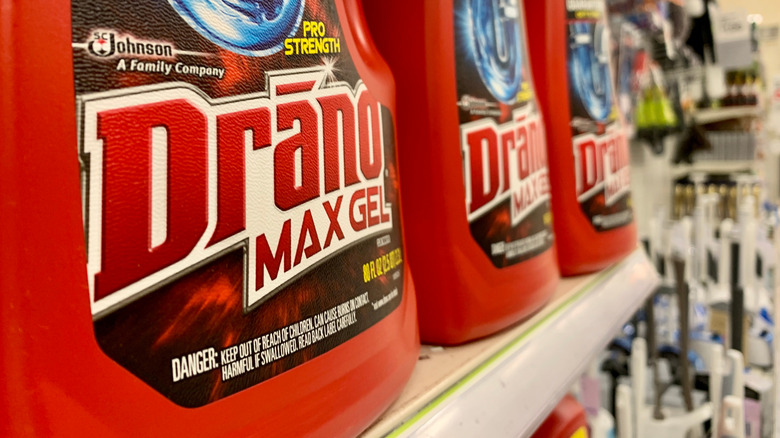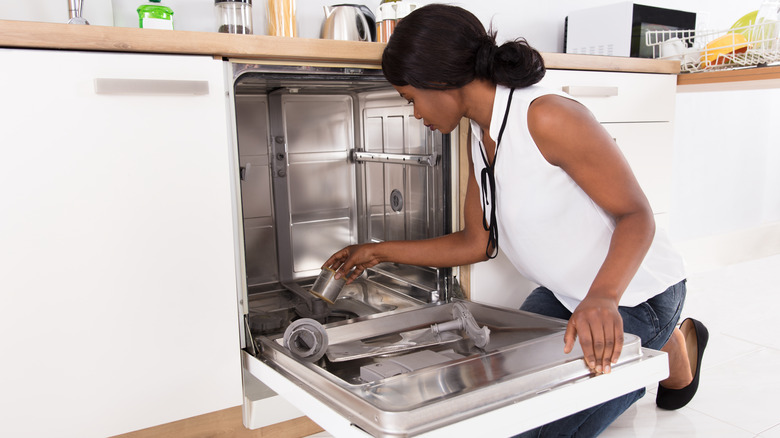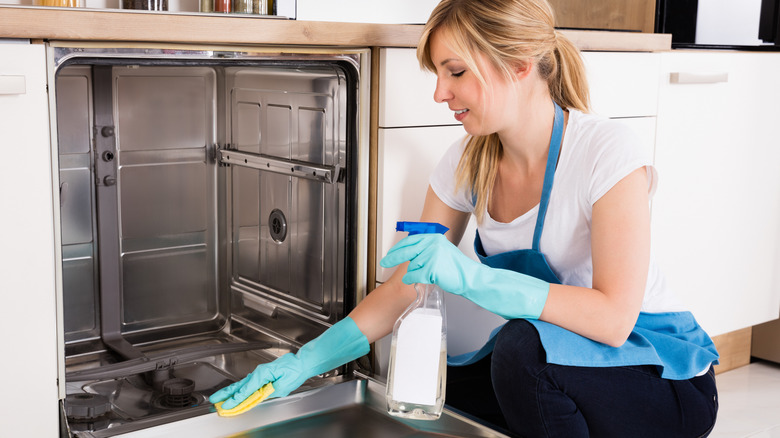Here's What Happens If You Use Drano To Unclog Your Dishwasher
A bottle of Drano is a lot of people's go-to product for unclogging a shower or sink pipe. Its magical powers do not extend to a dishwasher, however. In fact, if you attempt to unclog your dishwasher with Drano, you could end up with a bigger problem than where you began.
Smiley Drain says the reason for this lies in the chemical reaction that occurs when Drano is poured down a pipe. Drano is made up of several abrasive chemicals, including lye, aluminum, bleach, and sodium nitrate. When these chemicals combine, the result is a high-heat reaction that breaks down whatever is causing the clog. Some pipes can handle this intense heat, while others can be damaged.
With a dishwasher, you not only run the risk of damaging the drain pipe, but you can also ruin the pump as well as any exposed plastic or rubber materials. When that happens, you could end up paying hundreds of dollars to put in a new dishwasher. Even worse, if some of the Drano remains in your dishwasher and you proceed with the next wash cycle, your dishes could be contaminated with harmful chemicals that can cause burns, irritation, and even lung problems.
Unclogging your dishwasher without Drano
Unclogging your dishwasher the safer way involves a few checks, both inside and outside the unit. Within the unit, you'll want to scrub off any food debris and buildup that's accumulated along the bottom. Buildup also occurs in the filter of the dishwasher, so check there too. You'll likely need a screwdriver for this part, but once the case is off, you can easily pop the filter out for cleaning.
For the exterior of the dishwasher, there are two key areas to check and clean: At the air gap cylinder and inside the garbage disposal. Though it doesn't look like much, the air gap cylinder that sits behind or on top of your sink actually plays a crucial role in wash cycles by preventing backups and maintaining proper water flow. If the cylinder becomes loose or gets obstructed by buildup, it can cause the dishwasher to clog. While you're checking around the sink, take a look at the garbage disposal. Most built-in dishwashers drain through there. A full disposal won't drain properly.
If more checks are needed, take a dip beneath the sink. Look for any loose or damaged connections coming from the dishwasher or disposal, and make sure the drain hose is clear. If the dishwasher is still clogged after all checks are complete and all components have been cleaned or fastened, a call to the plumber might need to be next on your list.
Homemade alternative to Drano
If you still think your clogged dishwasher could benefit from some sort of liquid treatment, try a homemade remedy of vinegar and baking soda rather than Drano. Just pour equal parts of each into the bottom of the dishwasher, wait for 15 minutes or so, and then follow with hot water. After that, run the rinse cycle to remove any leftover baking soda or vinegar.
Once your unit is rid of that pesky clog, prevent future ones by keeping your dishwasher clean. The biggest help is scrapping excess food off your dishes before placing them inside for a wash. Another good habit to adopt is running a monthly maintenance cycle with either the vinegar and baking soda combo, a cup of white vinegar, or a specific dishwasher cleaner. Taking a sponge to the inside and the air gap cylinder can also help prevent buildup and keep your unit running smoothly.


